Papers by Desislava Angelova
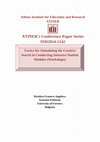
Design workshops are intensive modules which are increasingly used both in the students' training... more Design workshops are intensive modules which are increasingly used both in the students' training in design and in conducting various design related events. Their popularity is due mainly to the possibility of breaking the existing stereotypes and achieving a number of original solutions to a certain problem. Due to the limited time to reach the final solution in the workshops, the proper selection of design methods, aimed at enhancing the rapid generation of many ideas, is essential. The large amount of ideas and their variety are preconditions for the successful accomplishment of the assigned task. The present article is focused on the different stages of the idea generation phase and the possible tactics for their stimulation. Attention is drawn to the specifics of the design process in the different types of tasks. The information, presented in this article, is aimed at supporting students and lecturers, taking part in such intensive modules, which are successfully applied in the team work of students from the designs specialities. The aim of this article is to present tactics, successfully applied in the training of students from the speciality "Engineering Design" at the University of Forestry, as well as to assist the work of students and lecturers, taking part in such intensive courses.
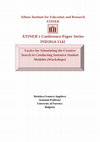
Design workshops are intensive modules which are increasingly used both in the students' training... more Design workshops are intensive modules which are increasingly used both in the students' training in design and in conducting various design related events. Their popularity is due mainly to the possibility of breaking the existing stereotypes and achieving a number of original solutions to a certain problem. Due to the limited time to reach the final solution in the workshops, the proper selection of design methods, aimed at enhancing the rapid generation of many ideas, is essential. The large amount of ideas and their variety are preconditions for the successful accomplishment of the assigned task. The present article is focused on the different stages of the idea generation phase and the possible tactics for their stimulation. Attention is drawn to the specifics of the design process in the different types of tasks. The information, presented in this article, is aimed at supporting students and lecturers, taking part in such intensive modules, which are successfully applied in the team work of students from the designs specialities. The aim of this article is to present tactics, successfully applied in the training of students from the speciality "Engineering Design" at the University of Forestry, as well as to assist the work of students and lecturers, taking part in such intensive courses.

Нуждата от опростяване и визуално олекотяване при съвременните столове е съобразена с водещата св... more Нуждата от опростяване и визуално олекотяване при съвременните столове е съобразена с водещата световна тенденция за дематериализиране на предметите от обитаемата среда. Целта е да се създадът оптически по-просторни и ненатоварващи възприятието интериори, изпълнени със светлина и въздушност. Постера цели да представи четрите основни похвати за постигане на тази тенденция, използващи се при съвременните столове. При първият похват се използват опростени конструктивни схеми. Формата се постига основно чрез пространствено огъване на листови детайли (един ила два детайла). При този тип структурно изграждане се предпочитат два материала: слоеста дървесина и метална ламарина, които впоследствие могат изцяло или частично да се тапицират за по-голямо удобство (напр. носеща метална основа и тапицирана носена част). Столовете, проектирани чрез този похват се отличават с минималистичната си нетрадиционна форма. Вторият похват залага на използване на пропускащи светлина материали. Посредством п...

The paper explores the creative output in seating furniture represented by works of prominent con... more The paper explores the creative output in seating furniture represented by works of prominent contemporary European and American designers. A comparative analysis of works created by such designers after 2000 and examples from the 20th century reveals the common and the different between the two. The active following and creative use of the familiar stylistic trends of the near past are cleverly combined with the possibilities offered by the new industrial methods and technologies of production. The interdisciplinary approach of research (a combination of engineering and artistic analysis) helps reveal the changes in the “language” of furniture design: the materials, construction, outline, colours, etc. and its organic link with the stylistics of the material world of the Postmodern time. Keywords: chair, material, construction, production technologies and techniques, stylistic trends
The design methods that stimulate students’ creative process and contribute to the rapid generati... more The design methods that stimulate students’ creative process and contribute to the rapid generation of ideas have been studied in this article. The aim of this report is to demonstrate the effectiveness of the methods and their application in the team student tasks. The applied methods stimulate the creative thinking by eliminating the mental blocks. These methods are characterized by the prominent role of the visual thinking in the construction of analogies and associations. This makes them extremely important for the design process, since the designer should be able to visualize his ideas.
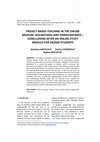
Bulletin of the "Transilvania" University of Braşov. Series II, Forestry, Wood Industry, Agricultural Food Engineering, Jun 25, 2024
In the paper, an analysis is made of an implemented short study module "Design Project" for the s... more In the paper, an analysis is made of an implemented short study module "Design Project" for the students of the "Engineering Design" Bachelor program from the University of Forestry in Bulgaria. The aim of this publication is to reveal the process, its failures, and its successes. The dynamics and evolution of the design process were followed during the five days of the study module. The interaction between the students themselves, the teaching staff and the sponsor was observed. To this end, the results of an inquiry are presented. In the conclusion, attention is directed to the online implementation of the Design Project and its influence, as a result of specific conditions (last year of study, the implementation of the Teams platform, the participating teaching staff, and the sponsor) which created the necessary environment for the event. It was found that the online module probably helped for a more concentrated and productive activity, and for the smooth procedures of the event without any waste of time.
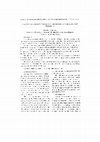
Innovations in Woodworking Industry and Engineering Design, 2013
ABSTRACT The analogy as a basic technique used in a number of design methods as a result of the a... more ABSTRACT The analogy as a basic technique used in a number of design methods as a result of the application of close and distant similarities from other areas, has been studied in the present report. It is based on a very common and recommended technique of creative thinking. Analogy is the basic means of the subjective logic of people, based on the systematic approach to the comparison of objects. Making analogies develops intuition and imagination, as in fact it is a result of the qualitative synthesis of the appearance of the technical system by a distant similarity. The professional development of designers is connected with the gradual acquisition and development of the capacity of synectic techniques. The analogies are very widely used in the design of industrial products. The creation of new products and services can be significantly enhanced by applying this technique, compared with the use of random ideas. The aim of this report is to show the effectiveness of this techniqu...
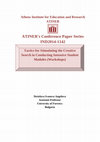
Design workshops are intensive modules which are increasingly used both in the students’ training... more Design workshops are intensive modules which are increasingly used both in the students’ training in design and in conducting various design related events. Their popularity is due mainly to the possibility of breaking the existing stereotypes and achieving a number of original solutions to a certain problem. Due to the limited time to reach the final solution in the workshops, the proper selection of design methods, aimed at enhancing the rapid generation of many ideas, is essential. The large amount of ideas and their variety are preconditions for the successful accomplishment of the assigned task. The present article is focused on the different stages of the idea generation phase and the possible tactics for their stimulation. Attention is drawn to the specifics of the design process in the different types of tasks. The information, presented in this article, is aimed at supporting students and lecturers, taking part in such intensive modules, which are successfully applied in th...











Uploads
Papers by Desislava Angelova